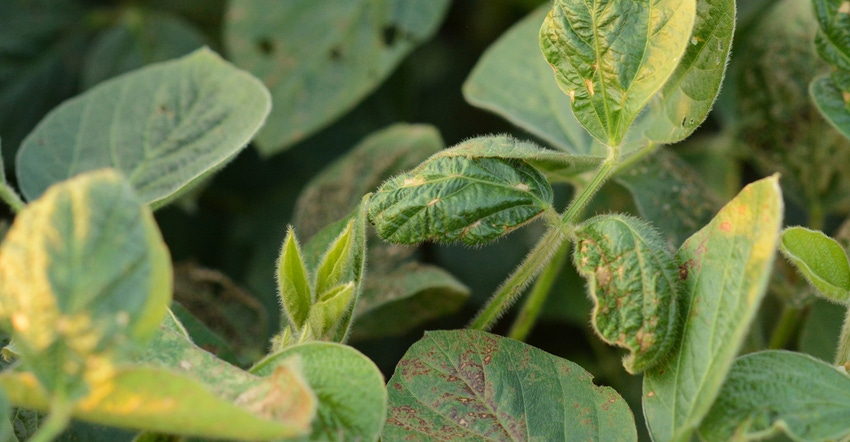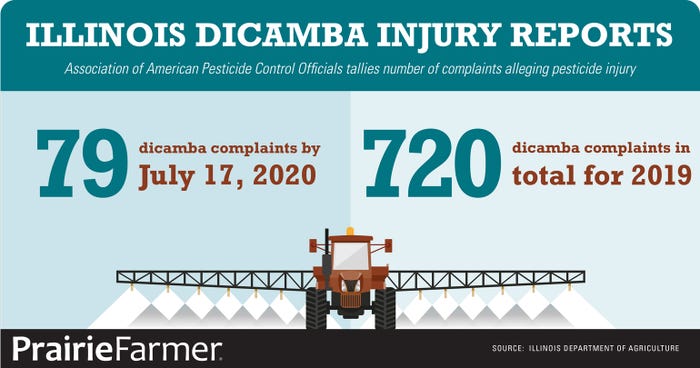
Illinois agriculture may be “flattening the curve” on dicamba complaints in 2020. As of last week, the Illinois Department of Agriculture has fielded just 79 dicamba misuse complaints for the 2020 season.
That’s a marked improvement compared to 2019, though Bureau Chief of Environmental Programs Doug Owens cautions reports are still coming in. And, it can take 14 to 21 days for dicamba-related symptomology to show up in affected plants.
“We’re in a pretty good spot right now, compared to last year, which was a terrible year for off-target movement of dicamba,” Owens says, adding that Illinois didn’t have the 85-degree-F temperature restriction in 2019. The state implemented that requirement for the 2020 season.
Last year’s dicamba cutoff date, delayed to July 15 due to widespread late planting, resulted in a swell of complaints as applicators across the state had to crunch their applications into a narrow, hot window. In 2019, 720 dicamba-related complaints were filed; there were 330 in 2018 and 246 in 2017.
Last year, as many as 75 complaints a day rolled into IDOA. Ultimately, the department issued more than 100 fines ranging from $750 to $1,000. At this point in the year, it appears the state has reversed the three-year trend of increasing complaint numbers, likely due to a June 25 cutoff and temperature restrictions for applicators, says Jean Payne, Illinois Fertilizer and Chemical Association president.
“We’ve seen more stories about dicamba this year from Iowa, Minnesota and Indiana, and not so much about Illinois,” Payne says. “That’s a welcome relief, compared to what we were dealing with in 2018 and 2019, when Illinois was ‘leading the pack’ in complaints.”
Other states that are dealing with record dicamba damage this year didn’t have a cutoff, other than the national cutoff put in place by U.S. EPA for the end of July. Minnesota has had a June 20 deadline in place since 2017 and just had its worst year for dicamba complaints since the cutoff took effect.

EPA’s cancellation of three dicamba labels left five days of scrambling among state departments of agriculture until June 8, when EPA issued guidance to allow existing stocks of XtendiMax, Engenia and Fexapan to be used until the end of July. IDOA added five days to Illinois’ dicamba application cutoff, originally set for June 20, directly because of the confusion EPA caused. That resulted in the June 25 cutoff.
Payne and Owens agree the confusion likely led to some applicators hurrying to apply the product when wind and temperature conditions were not ideal. The lost days from that situation likely helps explain the rush of complaints in states around the Midwest.
Payne says she works with ag retailers in Illinois who immediately ceased all applications after the court ruling was issued, even though a few of those days had acceptable low wind and temperature conditions.
In 2019, IDOA extended the cutoff date from June 30 to July 15. “During those first few weeks of July, there was no rain, and temperatures were very high,” Owens says. “We’re pretty sure that contributed to the amount of off-target movement we had then, so that’s why we put the temperature restriction in place for 2020.”
As the federal government prepares to potentially reregister dicamba labels for 2021, Payne says “a major soybean-producing state like Illinois dramatically reducing their complaints is significant. I hope it shows that some judicious level of use of this technology in soybeans may still be possible.”
Read more about:
DicambaAbout the Author(s)
You May Also Like




